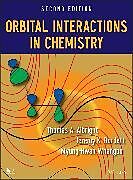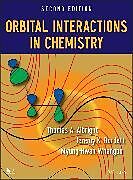Orbital Interactions in Chemistry
Einband:
Fester Einband
EAN:
9780471080398
Untertitel:
Englisch
Genre:
Chemie
Autor:
Albright Thomas A., Jeremy K. Burdett, Myung-Hwan Whangbo
Herausgeber:
John Wiley & Sons
Auflage:
2. Auflage
Anzahl Seiten:
848
Erscheinungsdatum:
29.03.2013
ISBN:
978-0-471-08039-8
Informationen zum Autor THOMAS A. ALBRIGHT! PhD! is Professor Emeritus in the Department of Chemistry at the University of Houston. He was a Camille and Henry Dreyfus Teacher-Scholar and an Alfred P. Sloan Research Fellow. He has been interested in exploring reaction dynamics in organometallic chemistry. The late JEREMY K. BURDETT! PhD! was Professor and Chair of the Chemistry Department at the University of Chicago. Dr. Burdett was awarded the Tilden Prize and Meldola Medal by the Royal Society of Chemistry. He was also a Camille and Henry Dreyfus Teacher-Scholar and a Fellow of the John Guggenheim Memorial Foundation and Alfred P. Sloan Foundation. MYUNG-HWAN WHANGBO! PhD! is Distinguished Professor in the Chemistry Department of North Carolina State University. He has been awarded the Camille and Henry Dreyfus Fellowship! the Alexander von Humboldt Research Award to Senior Scientists! the Ho-Am Prize in Science! and Docteur Honoris Causa from Universit de Nantes. Klappentext This advanced book on applied molecular orbital theory covers organic! organometallic! inorganic! and solid state chemistry to demonstrate how common orbital situations arise through the whole chemical spectrum. Zusammenfassung This advanced book on applied molecular orbital theory covers organic! organometallic! inorganic! and solid state chemistry to demonstrate how common orbital situations arise through the whole chemical spectrum. Inhaltsverzeichnis 23750515
Autorentext
THOMAS A. ALBRIGHT, PhD, is Professor Emeritus in theDepartment of Chemistry at the University of Houston. He was aCamille and Henry Dreyfus Teacher-Scholar and an Alfred P. SloanResearch Fellow. He has been interested in exploring reactiondynamics in organometallic chemistry. The late JEREMY K. BURDETT, PhD, was Professor and Chairof the Chemistry Department at the University of Chicago. Dr.Burdett was awarded the Tilden Prize and Meldola Medal by the RoyalSociety of Chemistry. He was also a Camille and Henry DreyfusTeacher-Scholar and a Fellow of the John Guggenheim MemorialFoundation and Alfred P. Sloan Foundation. MYUNG-HWAN WHANGBO, PhD, is Distinguished Professor inthe Chemistry Department of North Carolina State University. He hasbeen awarded the Camille and Henry Dreyfus Fellowship, theAlexander von Humboldt Research Award to Senior Scientists, theHo-Am Prize in Science, and Docteur Honoris Causa from Universit deNantes.
Klappentext
Explains the underlying structure that unites all disciplines in chemistry Now in its second edition, this book explores organic, organometallic, inorganic, solid state, and materials chemistry, demonstrating how common molecular orbital situations arise throughout the whole chemical spectrum. The authors explore the relationships that enable readers to grasp the theory that underlies and connects traditional fields of study within chemistry, thereby providing a conceptual framework with which to think about chemical structure and reactivity problems. Orbital Interactions in Chemistry begins by developing models and reviewing molecular orbital theory. Next, the book explores orbitals in the organic-main group as well as in solids. Lastly, the book examines orbital interaction patterns that occur in inorganic-organometallic fields as well as cluster chemistry, surface chemistry, and magnetism in solids. This Second Edition has been thoroughly revised and updated with new discoveries and computational tools since the publication of the first edition more than twenty-five years ago. Among the new content, readers will find: Two new chapters dedicated to surface science and magnetic properties Additional examples of quantum calculations, focusing on inorganic and organometallic chemistry Expanded treatment of group theory New results from photoelectron spectroscopy Each section ends with a set of problems, enabling readers to test their grasp of new concepts as they progress through the text. Solutions are available on the book's ftp site. Orbital Interactions in Chemistry is written for both researchers and students in organic, inorganic, solid state, materials, and computational chemistry. All readers will discover the underlying structure that unites all disciplines in chemistry.
Zusammenfassung
This advanced book on applied molecular orbital theory covers organic, organometallic, inorganic, and solid state chemistry to demonstrate how common orbital situations arise through the whole chemical spectrum.
Inhalt
1. ATOMIC AND MOLECULAR ORBITALS 1.1. Introduction, 1.2. Atomic Orbitals, 1.3. Molecular Orbitals, 2. CONCEPTS OF BONDING AND ORBITAL INTERACTION 2.1. Orbital Interaction Energy, A. Degenerate Interaction, B. Nondegenerate Interaction, 2.2. Molecular Orbital Coefficients, A. Degenerate Interaction, B. Nondegenerate Interaction, 2.3. The Two Orbital Problem -- Summary, 2.4. Electron Density Distribution, 3. PERTURBATIONAL MOLECULAR ORBITAL THEORY 3.1. Introduction, 3.2. Intermolecular Perturbation, 3.3. Linear H3, HF and theThree Orbital Problem, 3.4. Degenerate Perturbation, 4. SYMMETRY CONSIDERATIONS 4.1. Introduction, 4.2. Symmetry of Molecules, 4.3. Representations of Groups, 4.4. Symmetry Properties of Orbitals, 4.5. Symmetry-Adapted Wavefunctions, 4.6. Direct Products, 4.7. Symmetry Properties, Integrals and the Noncrossing Rule, 4.8. Principles of Orbital Construction Using Symmetry Principles, 4.9. Symmetry Properties of Molecular Vibrations, 5. MOLECULAR ORBITAL CONSTRUCTION FROM FRAGMENT ORBITALS 5.1. Introduction, 5.2. Triangular H3, 5.3. Rectangular and Square Planar H4, 5.4. Tetrahedral H4, 5.5. Linear H4, 5.6. Pentagonal H5 and Hexagonal H6, 5.7. Orbitals of a Systems, 6. MOLECULAR ORBITALS OF DIATOMIC MOLECULES AND ELECTRONEGATIVITY PERTURBATION 6.1. Introduction, 6.2. Orbital Hybridization, 6.3. Molecular Orbitals of Diatomic Molecules, 6.4. Electronegativity Perturbation, 6.5. Photoelectron Spectroscopy, 7. MOLECULAR ORBITALS AND GEOMETRICAL PERTURBATIONS 7.1. Molecular Orbitals of AH2, 7.2. Geometrical Perturbation, 7.3. Walsh Diagrams, 7.4. Jahn-Teller Distortions, A. First-Order Jahn-Teller Distortion, B. Second-Order Jahn-Teller Distortion, C. Three-Center Bonding, 7.5. Bond Orbitals and PE Spectra of AH2 Molecules, 8. STATE WAVEFUNCTIONS AND STATE ENERGIES 8.1. Introduction, 8.2. The Molecular Hamiltonian and State Wavefunctions, 8.3. The Fock Operator, 8.4. State Energy, 8.5. Excitation Energy, 8.6. Ionization Potential and Electron Affinity, 8.7. Electron Density Distribution and the Magnitudes of Coulomb and Exchange Repulsions, 8.8. Low vs. High Spin States, 8.9. Electron-Electron Repulsion and Charged Species, 8.10. Configuration Interaction, 8.11. The LDA Approach, 9. MOLECULAR ORBITALS OF SMALL BUILDING BLOCKS 9.l. Introduction, 9.2. The AH System, 9.3. Shapes of AH3 Systems, 9.4. a-Bonding Effects of Ligands, 9.5. The AH4 System, 9.6. The AHn Series -- Some Generalizations, 10. MOLECULES WITH TWO HEAVY ATOMS 10.1. Introduction, 10.2. A2H6 Systems, 10.3. Twelve-Electron A2H4 Systems, A. Sudden Polarization, B. Substituent Effects, C. Dimerization of AH2 and Pyramidalization of A2H4, 10.4. Fourteen-Electron AH2BH2 Systems, l0.5. AH3BH2 Systems, 10.6. AH3BH Systems, 11. ORBITAL INTERACTIONS THROUGH SPACE AND THROUGH BONDS 11.l. Introduction, 11.2. In-Plane o Orbitals of Small Rings, A. Cyclopropane, B. Cyclobutane, 11.3. Through-Bond Interactions, A. The Nature of Through-Bond Coupling, B. Other Through-Bond Coupling Units, 11.4. Breaking a C-C Bond, 12. POLYENES AND CONJUGATED SYSTEMS 12.1. Acylic Polyenes, 12.2. Huckel Theory, 12.3. Cyclic Systems, 12.4. Cross-Conjugated Polyenes, 12.5. Perturbations of Cyclic Systems, 12.6. Conjugation in Three Dimensions, 13. SOLIDS 13.1. Energy Bands, 13.2. Distortions of One…

Leider konnten wir für diesen Artikel keine Preise ermitteln ...
billigbuch.ch sucht jetzt für Sie die besten Angebote ...
Die aktuellen Verkaufspreise von 5 Onlineshops werden in Realtime abgefragt.
Sie können das gewünschte Produkt anschliessend direkt beim Anbieter Ihrer Wahl bestellen.
Loading...
Die aktuellen Verkaufspreise von 5 Onlineshops werden in Realtime abgefragt.
Sie können das gewünschte Produkt anschliessend direkt beim Anbieter Ihrer Wahl bestellen.
| # | Onlineshop | Preis CHF | Versand CHF | Total CHF | ||
|---|---|---|---|---|---|---|
| 1 | Seller | 0.00 | 0.00 | 0.00 |
